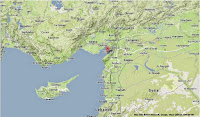The United States Geological Survey recorded
a Magnitude 5.2 Earthquake at a depth of 83.3 km, about 30 km to the northwest off the island of Rhodes slightly before midnight local time (slightly before 9.00
pm GMT) on Monday 27 September 2016. No damage or injuries have been reported following this event, but people have reported feeling the event from Rhodes and neighbouring islands, as well as much of the Anatolian (Turkish) mainland and as far away as Peleponesia in Greece.
The approximate location of the 23 September 2016 Rhodes Earthquake. Google.
The island of Rhodes lies on the boundary between the Anatolian Plate,
to the north, the Aegean Sea Plate (underlying
the Peloponnese, Attica, The Cyclades Islands, Crete, the Dodecanese
Islands and Turkey to the southeast of the Taurus Mountains) to the west and the African Plate to the south. Northern Greece
and the north coast of Turkey lie on the Eurasian Plate. Both countries
are highly prone to earthquakes because of this.
To the east the Arabian Plate is being pushed north and west by the movement
of the African Plate, further to the south. This leads to a zone of
tectonic activity within the province, as the Arabian and Anatolian plates are pushed
together, along the East Anatolian Fault, and past one-another, along
the Dead Sea Transform.
This movement also leads to a zone of faulting along the northern part
of Turkey, the North Anatolian Fault Zone, as the Anatolian Plate is
pushed past the Eurasian Plate, which underlies the Black Sea and
Crimean Peninsula (transform faulting). This is not a simple process,
as the two plates constantly stick together, then break apart as the
pressure builds up, leading to Earthquakes, which can be some distance
from the actual fault zone.
The Aegean Sea Plate is moving southwest with regard to the Eurasian and
Anatolian Plates, and being subducted beneath the African Plate to the
south. Its margin with the Eurasian Plate is a divergent and a transform
margin at different points. This is not a smooth process, with rocks
tending to stick together, then being forced to move as the pressure
builds up, typically in stops and starts that lead to Earthquakes.
Simplified map of the plate movements of the eastern Mediterranean. Univeriteit Utrecht.
Witness
accounts of Earthquakes can help geologists to understand these events,
and the structures that cause them. The international non-profit
organisation Earthquake Report is interested in hearing from people who may have felt this event; if you felt this quake then you can report it to Earthquake Report here.
See also...
 Magnitude 4.5 Earthquake off the coast of Hatay Province, southeast Turkey. The United States Geological Survey
recorded a Magnitude 4.5 Earthquake at a depth of 10 km, about 8 km
offshore of the city of İskenderun in Hatay...
Magnitude 4.5 Earthquake off the coast of Hatay Province, southeast Turkey. The United States Geological Survey
recorded a Magnitude 4.5 Earthquake at a depth of 10 km, about 8 km
offshore of the city of İskenderun in Hatay... Magnitude 6.9 Earthquake beneath the north Aegean Sea. The United States Geological Survey
recorded a Magnitude 6.9 Earthquake at a depth of 10 km beneath the
north Aegean Sea, close to the...
Magnitude 6.9 Earthquake beneath the north Aegean Sea. The United States Geological Survey
recorded a Magnitude 6.9 Earthquake at a depth of 10 km beneath the
north Aegean Sea, close to the...  Magnitude 6.4 Earthquake off the west coast of Crete. The United States Geological Survey recorded a Magnitude 6.4 Earthquake
at a depth of 36.2 km roughly 30 km off the west coast of Crete...
Magnitude 6.4 Earthquake off the west coast of Crete. The United States Geological Survey recorded a Magnitude 6.4 Earthquake
at a depth of 36.2 km roughly 30 km off the west coast of Crete...
Follow Sciency Thoughts on Facebook.


